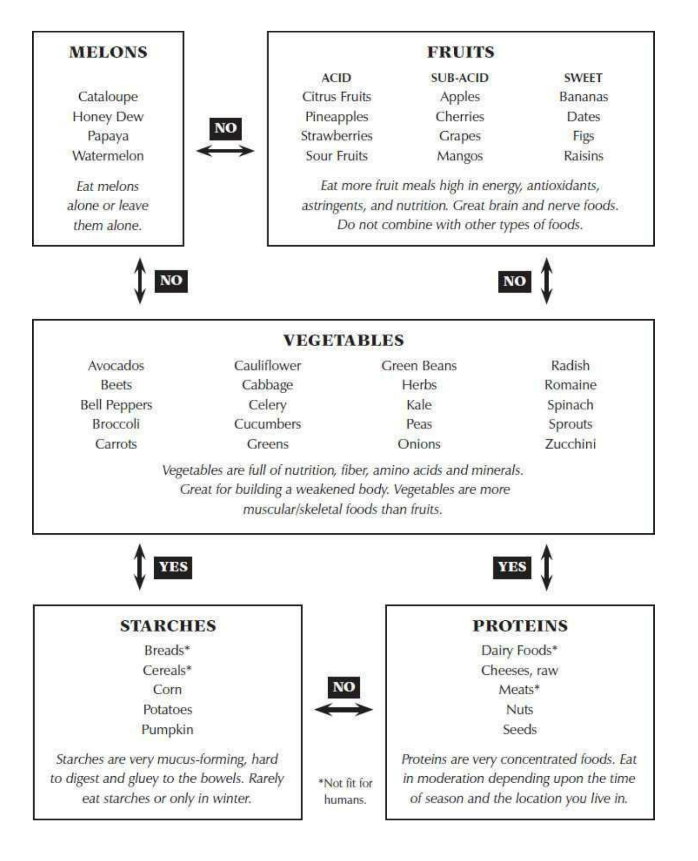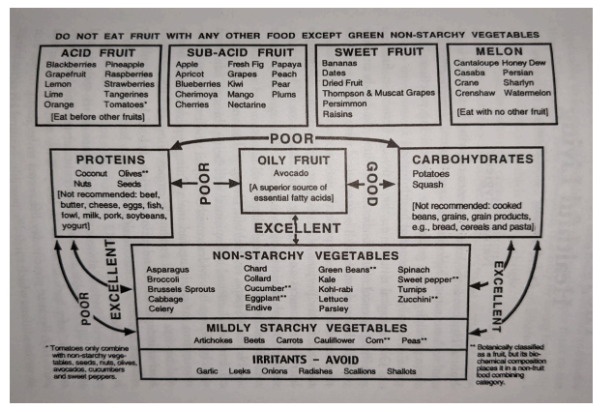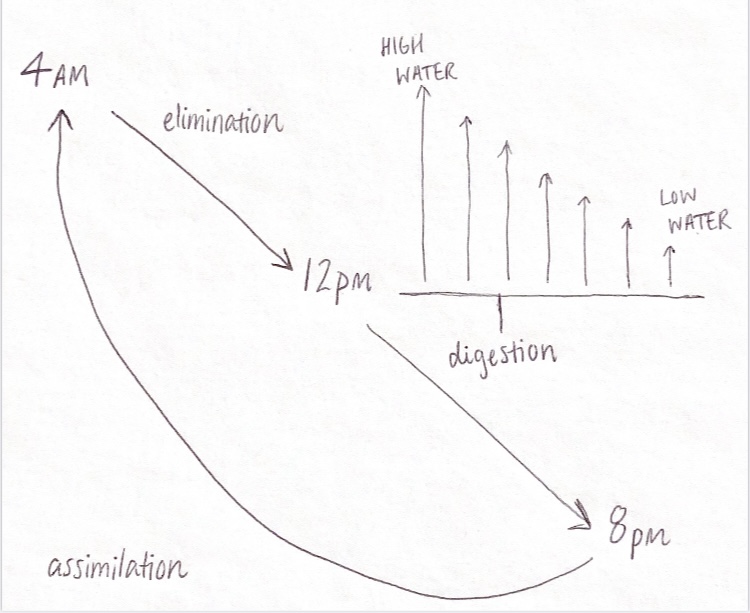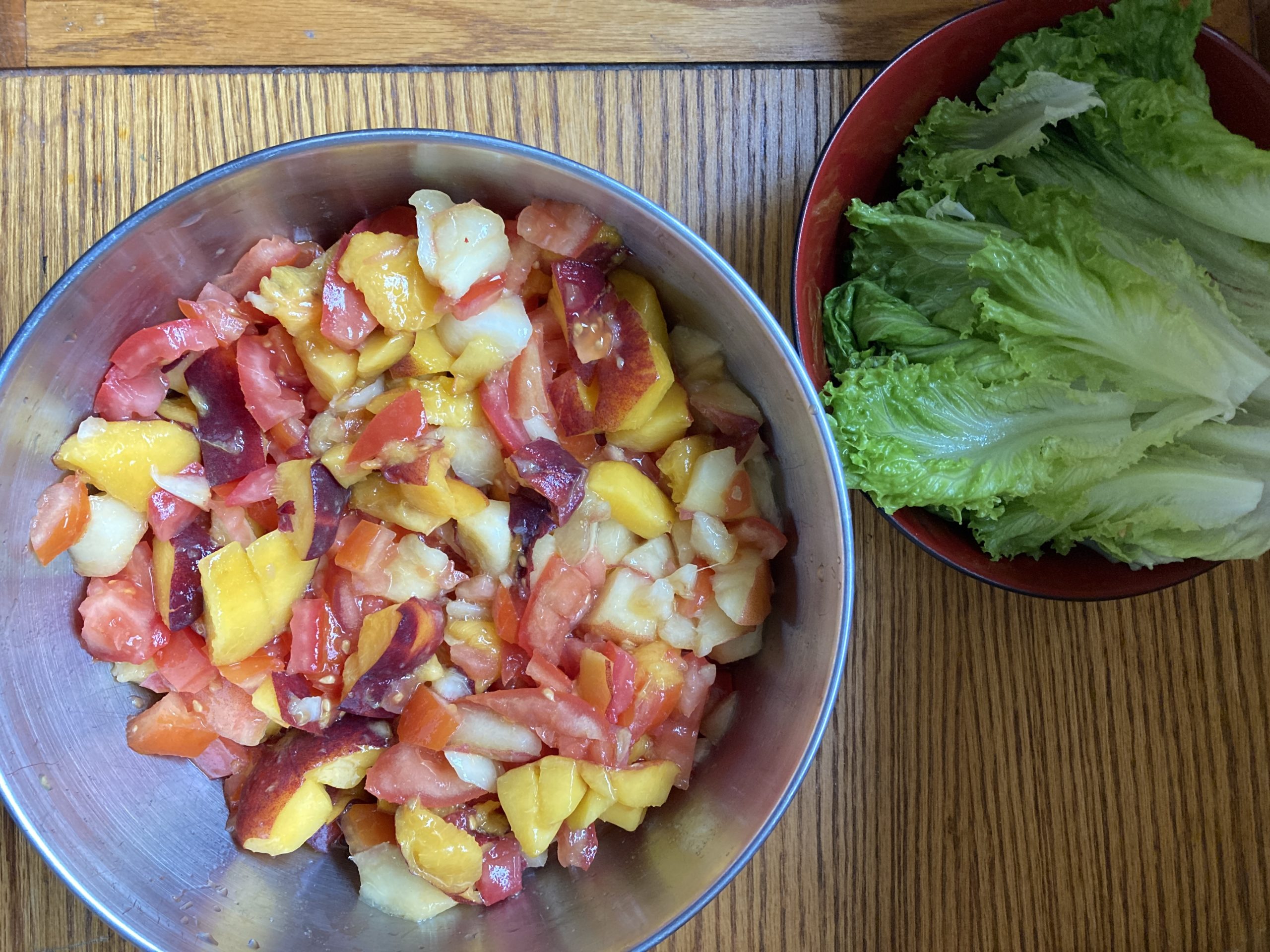The ideal case is emphasized on all topics in this article. By knowing the ideal, you know what to work towards for excellent health.
Food Combining Charts

(Chart from The Detox Miracle Sourcebook by Robert Morse, ND)

(Chart from Your Natural Diet: Alive Raw Foods by Dr. T. C. Fry and David Klein)
Caloric Intake
The total daily macronutrient ratio should be: Carbohydrates 80% / Proteins 10% / Fats 10%
This 80/10/10 ratio is taken from Dr. Douglas Graham’s book The 80/10/10 Diet and works well for most people. Fruit should be the majority of caloric intake. By doing this, it’s easy to keep protein and fat low. However, certain cases may need slight adjustments.
Meal Frequency
Two or three meals daily is ideal for the body, although some say one meal is better. The frequency of meals will depend on where you are in your transition to the diet. It can be difficult at first to fit in a large volume of food in one sitting. In this case, four meals may be more practical to consume enough calories. After some time (months to years) and especially after an extended water fast, the digestive system becomes cleaner and more efficient. In this case, two or three meals are enough to consume a sufficient amount of calories. It’s important to avoid grazing all day. Grazing leads to dental issues since the enamel of the teeth rarely gets a chance to remineralize in between meals. It also leads to disease since the body is left to continuously process food without rest.
Meal Spacing
It is best to leave 2-3 hours between each meal. This gives enough time for the tooth enamel to remineralize and for the surface pH to balance out. It also provides enough time for the food to leave the stomach.
Sequencing
It’s best when foods are eaten beginning with the most water-rich foods and ending with the least water-rich foods. This applies both throughout all meals and within one meal if more than one food is consumed. This looks like eating fruit all day and then a salad with an overt fat source like avocado as the last meal. Within a meal, this looks like eating peaches before bananas. Foods with higher water content digest quicker than foods with lower water content which digest slower. Eating in this order will allow all foods to move through the digestive system at their own pace. If done in reverse, this can lead to a “traffic jam” in the intestines (past the stomach) leading to gas formation from fermentation or putrefaction. Once a person has established a raw fruit-based diet for a longer period, they may be able to play with this order (ie. salad as a second-to-last meal, not the last) without many unfavorable effects.
The Body’s Energy Cycles
4 am – 12 pm – Elimination – energy is focused on eliminating digestive and cellular waste through the major eliminative organs: bowels, kidneys, lungs, and skin. This normally looks like bowel movements, urination, clearing of the nasal and oral passages, and sweating. This is a great time to exercise the body in your favorite way and drink most of your total water intake to support the movement of this waste.
12 pm – 8 pm – Digestion – energy is focused on digestion, absorption, and utilization of any nutrients consumed. This is the best period to eat any meals while taking into account meal spacing and proper food combining and sequencing. This can be 2-3 meals within this phase, but most importantly eating only when truly hungry and not overeating.
8 pm – 4 am – Assimilation – energy is focused towards assimilating nutrients into the body. Nutrients are used for repairing and renewing the body and the waste is prepared to eliminate in the next phase. As the sun sets and the moon starts to peak out, our energy is naturally drawn inward towards relaxation. This is the optimal time to “wind down” the body and mind from the day’s activities and to sleep.

Water Consumption
When eating the ideal foods, each food may need more or less time to digest and leave the stomach. We should not be drinking water with our meals since this will cause dilution of the stomach acid, which will interfere with optimal digestion (along with absorption, utilization, and elimination). A good rule of thumb is to wait 15 minutes after drinking water to start eating and wait 45 minutes after eating to start drinking water.
~~~~~
With proper application of these principles, one will be working in harmony with the body and not against it. Only improved health can result from this.
